Masculinity and Its Competing Performances
4Definitions of masculinity abound. Layering race, class, and historical setting into those definitions is a complex task indeed. Barbara Ransby and Tracye Matthews (1993) considered the complexities of black masculinity, defining the main characteristics as “the acquisition of money, violent military conquest, and the successful subjugation of women as domestic and sexual servants” (Guy-Sheftall 533). According to this definition, the black men in Tulsa’s Greenwood met all three criteria, and it was exactly in those areas that white men struck with the most ferocity. 5Considering white masculinity, we can get a sampling of perspectives from two ends of the political spectrum: a coach in the National Football League and a Radical Feminist, though neither overtly acknowledge that they are addressing white masculinity. Rather, their views reflect those identified by Adrienne Rich, who described the “perceptual practice that implicitly takes a white perspective as universal,” defining it as “white solipism” (qtd. in Alcoff 209). Even so, their definitions are useful. 6Former NFL player Joe Ehrmann discussed in a 2013 TedTalk what he called the “three myths of masculinity” which were (1) having a skill set, (2) engaging in sexual conquest, and (3) economic success. According to Ehrmann, these three attributes damage boys and men as they are seen as the end-all, be-all of manhood. 7Radical Feminist Valerie Solanas saw masculinity as an expression of longing for love and acceptance. Because she believed men to be incapable of love and honest acceptance, Solanas theorized that men expressed themselves through economics and violence. “Unable to give love or affection, the male gives money. It makes him feel motherly. The mother gives milk; he gives bread. He is the Breadwinner” (7). Still unsatisfied, the essential white man engages in “gratuitous violence, [which] besides ‘proving’ his is a ‘Man,’ serves as an outlet for his hate and, in addition […] provides him with a little sexual thrill” (31). Though these may seem like wildly divergent perspectives, Ehrmann and Solanas are both placing white masculinity in a framework of money and sex, two areas in which the white and black men of Tulsa would challenge each other’s ‘manliness.’ 8There can be no doubt that White Power reigned in 1921 Tulsa, Oklahoma. This expressed itself most clearly in the intersection of race and class. Linda Martin Alcoff (2006) connected the structures of capitalism and racial hierarchy, writing “[i]n a consumer society, the core of white privilege is the ability to consume anything, anyone, anywhere” (217). Because white men and black men were both economically successful in Tulsa, white men exercised their racial privilege by consuming black lives. 9In the ten years before the so-called riot, at least six people were lynched within sixty miles of Tulsa. On May 31, 1921, White Supremacists in Tulsa attempted to lynch their next victim, an African American teenager named Dick Rowland. Challenging that privilege, black men from Greenwood intervened to stop the lynching. Since the white perspective on black masculinity at this time was rooted in criminality and subservience, such an intervention inverted contemporary ideas on race and gender, and disturbed white men’s understanding of themselves, which we will return to in a bit. 10First, let us consider the setting of the Tulsa Race Riot of 1921. The setting of any social performance is an important component, especially when there are competing performers. When the settings shift, the performances sometimes become more essentialist, and other times they become more complex. As such, the impact of the interconnected, ever-evolving settings of lynchings and riots—two expressions of hyper-masculinity—cannot be overstated. 11Lynching, as performed in Oklahoma and other places in the American South during the Jim Crow Era, was soaked in the intersections of race, class, gender, and violence. Many of the white attackers that night in Tulsa had originally intended to engage in a lynching. Finding themselves temporarily without a script, social actors who appeared on the stage to participate in a lynching had to ‘switch hats’ when the invasion of Greenwood began. 12While race, class, gender, and violence are among the issues being examined here, lynching and rioting exists on different sociological plains. A social actor participating in a lynch mob is not the same as the social actor participating in a riot—they are two separate phenomena. (This is also part of the reason the term ‘riot’ must be rejected at every turn when discussing Tulsa in 1921.) The near-total destruction of black neighbors does share some common sociological characteristics with lynching, rioting, and warfare, but it is an oversimplification to reduce it to any one of the three. 13As previously mentioned, journalists and scholars who have studied the so-called riot almost all agree the term ‘riot’ is a misnomer. While the invasion of Greenwood was a collective action that resulted in damage to property and life, it was not an example of out of control behavior popularly associated with the term ‘riot.’ At first, near the jail where Dick Rowland was being held and the lynching was prevented, there was spontaneous violence between groups acting, to some extent at least, collectively. Members of the lynch mob and the group of armed black men clashed and then separated. It is at this point that the events of the evening and next day really diverge from ‘riotous’ behavior. What might be better termed The Tulsa Massacre or the Tulsa Uprising, depending on one’s point-of-view, was an extraordinarily organized attack on a minority group that was perceived to be partaking in some of the privileges of the dominant group. 14As the wealthiest black community in the nation, Greenwood had home-, property-, and business-owners numbering in the several hundreds. Professional men lay claim to American middle-class masculinity and all of its privileges. Families, schools, and churches were strong in Greenwood, under virtuous black male leadership. On the other end of the spectrum, less virtuous men exercised their privilege to access female bodies in the same brothels as Tulsa’s white men. 15Because white Tulsa was also largely middle-class, relative masculine equality existed in the uneasy setting of this peculiar time and place. The ‘last straw’ for white men came when the privilege of killing was treated as if both white men and black men had a say in it. When armed black men appeared at the county jail to prevent the lynching of Dick Rowland, lynchers transformed into so-called rioters, and declared a complete break between white masculinity and black masculinity.The Importance of Gender in Social Performance
16In her work on race, class, and gender, Aimee Meredith Cox (2015) theorized gender “is about performances and readings of those performances. When someone is illegible to another through the lens of normative gender categories, this is disconcerting primarily for what it means for disturbing the first person’s understanding of his or her own behavior, presentation, and knowledge of self” (181). In other words, when black men broke with the “normative gender categories” that cast them as either impotent or brutal, white men responded forcefully because of what they felt it said about white masculinity. If black men were not brutal, incompetent beasts, then white men did not need to be brave and powerful protectors in their daily lives. Without this element, white masculinity would be something very different. Therefore, white Tulsans responded negatively to the assertion of a newly constructed black masculinity. 17That negative white response manifested first with a stand-off at the jail where the lynching was set to take place. Steven Lukes described the “most insidious exercise of power” as being the kind in which the dominant group shapes the perceptions of the minority group “in such a way that they accept their role in the existing order of things, either because they can imagine no alternative to it, or because they see it as natural and unchangeable” (28). 18By the spring of 1921, white control of the black imagination in Oklahoma had begun to lose its grip. Demonstrating their unwillingness to “accept their role in the existing order of things,” black men openly challenged the white lynch mob outside the jail. After receiving assurances from the sheriff that no lynching would be allowed to proceed, armed black Tulsans returned to Greenwood. White Tulsans then looted pawn shops and hunting supply stores, coming away heavily armed. Rather than hiding, many of the black men of Tulsa returned to the jail, determined to participate actively in unfolding events. 19Journalist Tim Madigan tells of the encounter that would spark the total destruction of Greenwood, a spark that ignited when fragile white masculinity challenged the strength of black masculinity:20This was the beginning of the so-called Tulsa Race Riot. Returning to Greenwood, the black resisters were followed by men acting as agents of White Power. Spending the night and much of the next day attacking the entire community of Greenwood, white males were laying exclusive claim to the social location of ‘successful men’ through a violent expression of white masculinity.An old white man, short and frail, went after the largest Negro of them all, the famous black veteran O.B. Mann. The white barely came to Mann’s belt buckle.
“Nigger, what are you going to do with that pistol?” the old white man demanded.
“I’m going to use it if I need to,” Mann replied.
“No, you give it to me,” the white man said.
“Like hell I will,” Mann replied.
The old white man was in no mood for insolence. He lunged for Mann’s pistol, and the gun discharged in the brief tussle that ensued. A hundred other shots rang out within seconds, sending the panicked mass of men, women, and children fleeing in all directions at once […]. At least twenty people, both whites and Negroes, lay dead or wounded. The old white man who had confronted O.B. Mann was among the first to die (102–03).
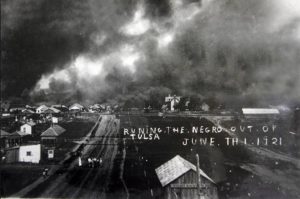
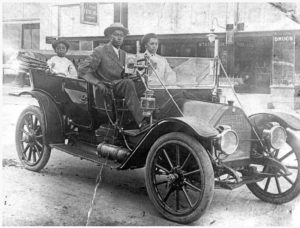
As the so-called riot stretched into the night and the next day, with ever-increasing levels of violence on both sides, markers of masculinity like economic success, the respect that comes from military combat, and access to women’s bodies (which we will come to later), all became contested sites of power.
The Importance of Power in Social Performance
22Performance, and/or the right to refuse performance, is the essence of power. Dominant groups maintain the discretion to decide when they will perform, and how they will react to and help shape the performances of minority groups. As Foucault tells us, “power is exercised rather than possessed” (Discipline and Punish 26). Oppressed groups are affected by the dominant performance of power in a particularly detrimental way. “It invests them; is transmitted by them and through them; it exerts pressure upon them, just as they themselves, in their struggle against it, resist the grip it has on them” (27). Indeed, investment, transmission, pressure, and struggle define the interactions between black men and white men in 1921 Tulsa, interactions that had at their core a contest to determine which men had the right to exercise power. Indeed, which men had the right to claim, and perform, manhood?Power and Gender Intersect
23It is important to note how white men were performing masculinity, and how they were interpreting the performance of black masculinity, in the period leading up to the so-called riot. Protection of and provision for the family, economic success, and combat experience were common characteristics in Tulsa’s white male population. Experience in the war helped personal masculine traits associated with protecting wife and family conflate with communal masculinity, which was framed as the ultimate protector of all Americans and free people around the world. Once home, that communal masculinity reverted to previous boundaries of protecting all white women and children. Expressions of hyper-masculinity among groups like the Ku Klux Klan—a strong presence in 1921 Tulsa—were not uncommon. 24To that end, threats against white women and children were often exaggerated, or outright fabricated, in order to provide a stage on which racialized white masculinity could be performed. Indeed, it was a supposed attack on a white teenager named Sarah Page, on-again, off-again girlfriend of the intended lynching victim Dick Rowland, that brought white men to the Tulsa jail on the night of May 31 in the first place.The Benefits of Masculinity Membership
25Sociologists attempting to explain ethnic discrimination have theorized about the psychic and material gain experienced by dominant groups. Specifically, John Dollard (1933) conducted a case-study on an unnamed “Southerntown.” In studying the Jim Crow social structure, he identified three “gains” experienced by white men as a result of the simultaneous operations of White Supremacy and Patriarchy. 26The “prestige gain” is achieved in a social setting like Jim Crow Oklahoma because any “member of the white caste [had] an automatic right to demand forms of behavior from Negroes which serve to increase his own self-esteem” (Dollard 174). Of course, this situation heavily influenced performances of white masculinity, but it also shaped understandings of black masculinity. As Franz Fanon put it, “not only must the black man be black; he must be black in relation to the white man” (82–83). 27Additionally, Marilyn Frye described whiteliness as “a socially constructed racial status which confers entitlements and authority” (qtd. in Alcoff 210). Whiteliness, white masculinity, and the prestige gain cannot be separated from one another. They are not only intersecting social structures, they are fully and irrevocably intertwined social structures. The prestige gain, from the middle-class white male perspective, was seriously threatened by the presence of black doctors, lawyers, property- and business-owners in Greenwood. 28The “economic gain” refers to the material benefits obtained by dominant group members as a result of their power to oppress and/or exploit minority group members (Dollard 97). Economic domination was a major characteristic of the Jim Crow Era. Indeed, contested economic power was at the root of much of the racialized violence across the South. Building a successful black community in the heart of Jim Crow Oklahoma, residents of Greenwood freed themselves from racialized economic oppression and exploitation, or at least lessened the extent to which it was experienced. In doing so, they denied white Tulsans the economic gain inherent in White Supremacy. 29The third gain identified by Dollard is the “sexual gain” (134). As Ransby and Matthews, Ehrmann, and Solanas all noted, sexuality and access to female bodies are considered defining characteristics of masculinity. By maintaining a racialized patriarchy, male members of the dominant group maintained exclusive access to white women’s bodies while exercising power and privilege to also freely access black female bodies. In doing so, they were demonstrating power over black men, as well as all women. This is not new information, but it is important to note because of how it affected the ways black and white gendered bodies acted out the Tulsa Race Riot of 1921. 30The fact that White Power exerted itself physically in the ‘riot,’ rather than in a court of law or in a classroom, speaks to the “political economy of the body” (Foucault, Discipline and Punish 25). The political economies of black bodies and white bodies were not equal in 1921, just as the political economies of female bodies and male bodies were not equal. The intersection of race and gender, of power and domination, of privilege and deprivation, all wove together to create a complex social fabric which blanketed almost every social interaction in 1921 Tulsa. 31One of the privileges white men have historically enjoyed is unquestioned access to the white woman’s body, a site where racialized masculinity finds one of its strongest performances. Throughout American history, they have been reluctant to share that privilege, and sometimes have violently defended it. This was especially true in the early 20th century. While attacks on men of color were presented as necessary for the protection of white women, it is probably more true that they were assertions of racialized masculinity against those perceived as sexual competitors. 32Black men also saw the white woman’s body as a space to compete with white men. Boxing’s first African American heavyweight champion of the world, and native of neighboring Texas, Jack Johnson exemplified this attitude. Johnson dated, married, and purchased white women’s bodies, using them as trophies of his success in the competition between racialized masculinities. Acknowledging Johnson’s participation in the contest while refusing to accept his possible victory, white authorities prosecuted Johnson under the Mann Act of 1910. 33Ostensibly, the Mann Act was designed to protect white women from human trafficking, but in practice, it was a Jim Crow race control measure. Rejecting the legal and social discipline of white society, Johnson declared “I have the right to choose who my mate shall be without the dictation of any man” (Burns). This declaration signifies that the primary conflict and decision-making was taking place among men, with women’s bodies merely providing the stage on which to compete. 34Privileged access to white female bodies was closely guarded by the Ku Klux Klan. Claiming preservation of Christian values and virtuous protection of white women among their aims, the KKK provided no leeway when it came to contact between black men and white women, as demonstrated by the fact that Dick Rowland was cast as a rapist for touching Sarah Page, either by grabbing her arm or by tripping and accidentally making contact with her. However, application of Christian virtues could be flexible when it came to contact between white men and women. 35For example, Richard Lloyd Jones, the incendiary editor of the Tulsa Tribune, probably the man most single-handedly responsible for inciting the Tulsa Race Riot, and husband of a white wife, was investigated by the Klan for infidelity. Following Jones to a hotel, Klan members spied on sex acts between Jones and his white assistant, Amy Comstock, carefully documenting that “she was like an old maid’s cat. She looked a little bit tired and very much satisfied” (Madigan 44). When Jones and Comstock had warrants issued for their arrests for lewd conduct, the KKK stepped in and protected Jones’ privilege to access any female body he chose, especially they said, since he was “a friend of the Klan” (44). 36Though white men often referred to the need to protect “our women” from assault, exploitation, and disrespect, a comparison of the white reaction to Richard Lloyd Jones and to Dick Rowland demonstrates that the protection and competition were not really about the women at all. Rather, it was about maintaining the site of white female bodies as a space for exclusive performance of privileged white masculinity. When black men attempted to access that site, it was the masculinity of white men that was threatened, and it was that which was truly being defended. 37The only time black men and white men shared the stage of female bodies was in the realm of prostitution, as briefly mentioned earlier. Brothels in Greenwood provided both black and white female bodies for use by both black and white men. Not surprisingly, offering a stage on which black men and white men could perform as equals in the domination of women did not guarantee any level of protection on the night of the ‘riot.’ Every brothel in Greenwood was burned to the ground.The Effect of and on Racialized Femininity
38The Tulsa performance of masculinity had as one consequence the concretization of ideas about racialized femininity. The dominant group was able to shape the narrative of their own performance to legitimize notions about American womanhood. White women were cast in the role of feminine (supportive) victims and/or participants, while black women were cast as masculinized (resistant) outliers. When the actual race of a particular woman did not match with her assigned role, she was simply written out of the history of the event. 39This is best seen in the denial of black female victimhood. Almost all articles written in the first fifty years after the ‘riot’ focus on Sarah Page, Dick Rowland’s white girlfriend and confessed-false accuser, as the sole female victim in the Tulsa Race Riot of 1921. The scores of black women who were killed, displaced, humiliated, or made to suffer the loss of a child, sibling, husband, or parent, were little more than footnotes in written histories, having their forced performance of black feminine victimization rejected because it did not fit the narrative the dominant group wanted to tell. 40Meanwhile, white women often literally followed behind white men as they moved house to house destroying Greenwood. White mothers and daughters looted unrepentantly, as if all material goods were inherently theirs for the taking. When items were too large to be easily carried, such as pianos, they informed white men who backed pickup trucks into Greenwood’s front yards, loading up valuables before putting the homes to the torch.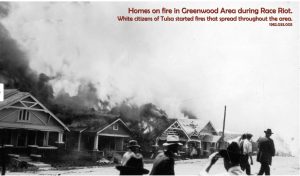
Social Death and the Modeling of Masculinity
42An important element of the (re)construction of white masculinity was the destruction of black masculinity. Outright murder is the most obvious way this was accomplished in 1921 Tulsa, but humiliation of black men and their families also played a key role. By displaying women and children in the detention camps (and in the case of at least one black woman, hanging her off a telephone pole for public display), black masculinity was shown as being incapable of providing or protecting, two characteristics essential to notions of masculinity in America. Furthermore, by naming the attack a ‘riot,’ complex performances of resistance and strength were erased and black masculinity was stripped of its power. The complete destruction by fire of the setting in which powerful black masculinity was played out—middle-class homes and businesses—completed the de-construction of economically successful black masculinity in 1921 Tulsa, resulting in a kind of “social death” (Patterson).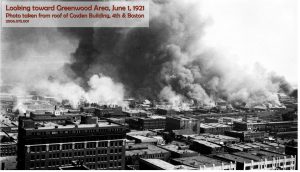
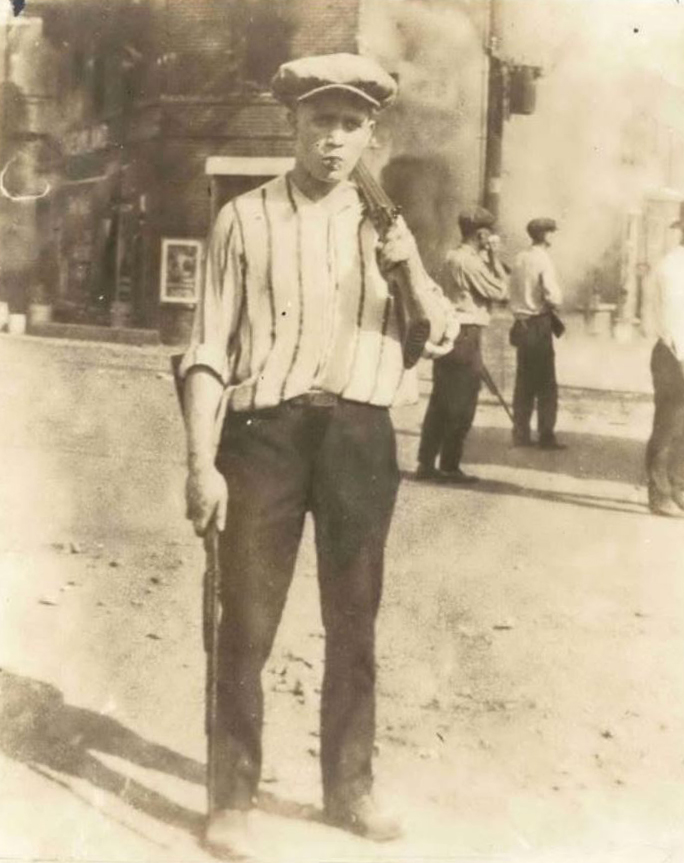
51As boys and young men absorbed and practiced the concepts of racialized masculinity, they and their fathers were also engaged in a profound unsettling of power structures. Where the dust settled would help determine the rights and privileges of both races for almost a century to come. While the combatants were equals in terms of class and gender, the dividing line between them, race, meant that one group had access to ‘legitimate’ legal organizations such as the police, sheriff’s department, and eventually, the National Guard. 52During the night, approximately five hundred white men were deputized and given instructions to “Get a gun and get a nigger” (Madigan 118). Deputization meant white male bodies became moving sites of authority. Wherever these men went and whatever they did during the ‘riot’ was protected under the auspices of legal authority. This was an especially sensitive reassertion of the authority of white masculinity because of its time and place. White men and black men had fought in World War I just a few years earlier, laying legitimate claim to identities such as warrior, hero, and perhaps the most-contested identity of them all, man. Some black men had been known to wear their military uniform around town or to patriotic parades, essentially performing their re-worked ideas of black masculinity for all to see. Deputizing white men not only provided them the temporary legal cover needed to commit their crimes, it was a re-situating of the right to fight and the right to rule, transferring it from black veterans to any white man who would stand in line for a badge. 53Triumphant in this struggle between American manhoods, white (masculine) authorities used black bodies as sites of punishment and control after the “riot.” Black survivors were marched down the streets and held in makeshift detention camps for over a month. Through looting and arson, forced detention, and murder, the white men of Tulsa exerted masculinity in line with Michel Foucault’s idea of power as “essentially a right of seizure: of things, time, bodies, and ultimately life itself” (History of Sexuality 136).In all my experience, I have never witnessed such scenes as prevailed in this city when I arrived at the height of the rioting. Twenty-five thousand whites, armed to the teeth, were ranging in utter and ruthless defiance of every concept of law and righteousness. Motor cars bristling with guns swept through the city, firing at will. (Madigan 174)
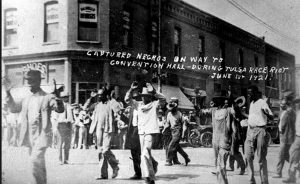
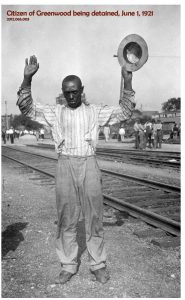
Public marching down the streets at gunpoint, hanging dead bodies from telephone poles, and forcing detainees to ride in truck beds with dead bodies also all had the effect of emasculating black men who had claimed as their masculine privilege the right to defend their bodies, their lives, their families, their homes, and their businesses.
Conclusion
55Like most social scenes, 1921 Tulsa was extremely complex. By considering the role gender and masculinity played in the ‘riot,’ I do not intend to downplay race or class. Rather, I hope to deepen our understanding of how social actors act and react based on the intersection of sometimes contradictory power structures. Not all men experience the same benefits within patriarchies, especially when those patriarchies are racialized. The Tulsa Race Riot of 1921 was not a simple exertion of racial and economic control. It was also an exertion of gender control, with the aim of emasculating black men.Note
[1] Even a cursory survey of events reveals the label ‘riot’ to be a misnomer. Rather than a riot, the events of 1921 were a controlled exertion of White Power which was met with an organized defense of black resistance. As such, this author will utilize quotation marks, the term ‘so-called,’ or the fully capitalized historical title of Tulsa Race Riot of 1921.
Works Cited
Alcoff, Linda Martin. Visible Identities: Race, Gender, and the Self. Oxford: Oxford UP, 2006. Print.
Burns, Ken, dir. Unforgivable Blackness: The Rise and Fall of Jack Johnson. Florentine Films, 2005. Film.
Cox, Aimee Meredith. Shapeshifters: Black Girls and the Choreography of Citizenship. Durham, NC: Duke UP, 2015. Print.
Dollard, John. Caste and Class in a Southern Town. New York: Doubleday, 1933. Print.
Fanon, Frantz. Black Skin, White Masks. New York: Grove, 1952. Print.
Foucault, Michel. Discipline and Punish: The Birth of the Prison. New York: Vintage, 1976. Print.
—. The History of Sexuality, Vol. I: An Introduction. New York: Vintage, 1978. Print.
Gaventa, John. Power and Powerlessness: Quiescence and Rebellion in an Appalachian Valley. Chicago: U of Illinois P, 1980. Print.
Guy-Sheftall, Beverly, ed. Words of Fire: An Anthology of African-American Feminist Thought. New York: New P, 1995. Print.
Hirsch, James S. Riot and Remembrance: The Tulsa Race War and Its Legacy. Wilmington: Mariner, 2003. Print.
Lukes, Steven. Power: A Radical View. 2nd ed. New York: Palgrave, 2005. Print.
Madigan, Tim. The Burning: Massacre, Destruction, and the Tulsa Race Riot of 1921. New York: Dunne, 2001. Print.
Messer, Chris M. “The Tulsa Race Riot of 1921: Toward an Integrative Theory of Collective Violence.” Social History 44.4 (2011): 1217–32. Print.
Messer Chris M., and Patricia A. Bell “Mass Media and Governmental Framing of Riots: The Case of Tulsa, 1921.” Black Studies 40.5 (2010): 851–70. Print.
Patterson, Orlando. Slavery and Social Death. Cambridge: Harvard UP, 1982. Print.
Ransby, Barbara, and Tracye Matthews. (1993) “Black Popular Culture and the Transcendence of Patriarchal Illusions.” Words of Fire: An Anthology of African-American Feminist Thought. Ed. Beverly Guy Sheftall. New York: New P, 1995. 525–36). Print.
Solanas, Valerie. The SCUM Manifesto. New York: Penguin, 1969. Print.
Author
Hollie A. Teague is a doctoral student in the Sociology Department of Texas Woman’s University. She holds a Master’s Degree in US History and works as a high school teacher. Her major research interests include race, class, and gender in early twentieth-century North Texas and Oklahoma.
Suggested Citation

This work is licensed under a Creative Commons Attribution-ShareAlike 3.0 Unported License.


